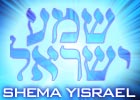When a Jew closes their eyes while saying the Shema, it symbolizes a temporary removal from the physical world and a connection to the spiritual realm. Just as we close our eyes in death to transition to the afterlife, closing our eyes during the Shema helps us focus on the spiritual message of the prayer.
Overall, the Shema is a powerful affirmation of Jewish faith, unity, and tradition. It serves as a daily reminder of our commitment to God, our connection to our heritage, and our belief in the ultimate oneness of the divine. Saying the Shema each day helps us strengthen our relationship with God and live our lives in accordance with Jewish values and teachings.
Here is the text of the Shema:
Shema Yisrael, Adonai Eloheinu, Adonai Echad.
Hear, O Israel, the Lord our God, the Lord is One.
Baruch Shem Kevod Malchuto Leolam Vaed.
Blessed be the Name of His glorious kingdom for ever and ever.
V’ahavta et Adonai Elohecha b’chol levavcha uvchol nafshecha uvchol meodecha.
And you shall love the Lord your God with all your heart, and with all your soul, and with all your might.
Reciting the Shema is a powerful way to connect with God and unite with others in prayer. It is a reminder of our love for God and our commitment to serving Him with all our heart, soul, and resources. May we all strive to fulfill this commandment every day and bring more light and unity into the world. To properly recite the prayers without a minyan, it is essential to enunciate each word clearly and not rush through them. Begin with the three-word formula: “God, trustworthy King.” Recite the first verse aloud, covering your eyes with your right hand, and focus on accepting God’s absolute sovereignty. The next verse, “Hear, O Israel: the Lord our God, the Lord is One,” should be recited in a clear voice.
In an undertone, say: “Blessed is the Name of His glorious kingdom for all eternity.” While reciting the first paragraph (Deut. 6:5-9), concentrate on accepting the commandment to love God. Touch the arm-tefillin at “Bind them…” and the head-tefillin at “and let them be tefillin…”, then kiss your fingertips.
The second paragraph (Deut. 11:13-21) should be recited with focus on accepting all the commandments and the concept of reward and punishment. Touch the arm-tefillin at “Bind them…” and the head-tefillin at “and let them be tefillin…”, then kiss your fingertips.
Before reciting the third paragraph (Numbers 15:37-41), hold the tzitzit in your left hand, and then take them in your right hand as well. Kiss the tzitzit at each mention of the word “tzitzit” and at the end of the paragraph. Pass them before your eyes at “that you may see it.”
The above instructions are reprinted with permission from the ArtScroll Siddur. You can also refer to the transliteration provided to recite the prayers in Hebrew. Remember to recite each word clearly and with intention.
For a WordPress-friendly version of this article, including the HTML tags, images, headers, and key points, please use the content provided above. Regenerate means to restore or renew something to its original or better condition. It can refer to physical regeneration, such as the regrowth of tissue or cells, or it can be used figuratively to describe the process of revitalizing or rejuvenating something.
Source link

